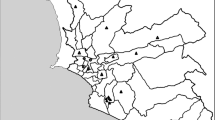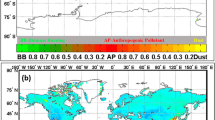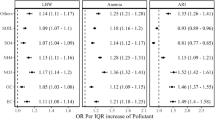Abstract
Background
Characterizing the spatial distribution of PM2.5 species concentrations is challenging due to the geographic sparsity of the stationary monitoring network. Recent advances have enabled valid estimation of PM2.5 species concentrations using satellite remote sensing data for use in epidemiologic studies.
Objective
In this study, we used satellite-based estimates of ambient PM2.5 species concentrations to estimate associations with birth weight and preterm birth in California.
Methods
Daily 24 h averaged ground-level PM2.5 species concentrations of organic carbon, elemental carbon, nitrate, and sulfate were estimated during 2005–2014 in California at 1 km resolution. Birth records were linked to ambient pollutant exposures based on maternal residential zip code. Linear regression and Cox regression were conducted to estimate the effect of 1 µg/m3 increases in PM2.5 species concentrations on birth weight and preterm birth.
Results
Analyses included 4.7 million live singleton births having a median 28 days with exposure measurements per pregnancy. In single pollutant models, the observed changes in mean birth weight (per 1 µg/m3 increase in speciated PM2.5 concentrations) were: organic carbon −3.12 g (CI: −4.71, −1.52), elemental carbon −14.20 g (CI: −18.76, −9.63), nitrate −5.51 g (CI: −6.79, −4.23), and sulfate 9.26 g (CI: 7.03, 11.49). Results from multipollutant models were less precise due to high correlation between pollutants. Associations with preterm birth were null, save for a negative association between sulfate and preterm birth (Hazard Ratio per 1 µg/m3 increase: 0.973 CI: 0.958, 0.987).
This is a preview of subscription content, access via your institution
Access options
Subscribe to this journal
Receive 6 print issues and online access
$259.00 per year
only $43.17 per issue
Buy this article
- Purchase on Springer Link
- Instant access to full article PDF
Prices may be subject to local taxes which are calculated during checkout



Similar content being viewed by others
Data availability
The datasets used and/or analyzed during the current study are available from the corresponding author on reasonable request.
Notes
Crosswalk tables to match non-geographically bound zip codes to a ZCTA, such as the Uniform Data System Mapper (https://udsmapper.org/zip-code-to-zcta-crosswalk/), are available; however, we could not guarantee the mother would physically reside in the matched ZCTA, so we elected to not match the non-geographically bound zip codes to a ZCTA.
References
Harris G, Thompson WD, Fitzgerald E, Wartenberg D. The association of PM2.5 with full term low birth weight at different spatial scales. Environ Res. 2014;134:427–34.
Liu L, Oza S, Hogan D, Perin J, Rugan I, Lawn J, et al. Global, regional, and national causes of child mortality in 2000–13, with projections to inform post-2015 priorities: an updated systematic analysis. Lancet. 2015;385:430–40.
Sun X, Luo X, Zhao C, Zhang B, Tao J, Yang Z, et al. The associations between birth weight and exposure to fine particulate matter (PM2.5) and its chemical constituents during pregnancy: a meta-analysis. Environ Pollut. 2016;211:38–47.
Sun X, Luo X, Zhao C, Chung RW, Lim C, Zhang B. The association between fine particulate matter exposure during pregnancy and preterm birth: a meta-analysis. BMC Pregnancy Childbirth. 2015;15:300.
United States Environmental Protection Agency. Integrated science assessment for particulate matter. Research Triangle Park; 2019.
Chen L, Lippmann M. Effects of metals within ambient air particulate matter (PM) on human health. Inhal Toxicol. 2009;21:1–31.
Kelly F, Fussell J. Size, source and chemical composition as determinants of toxicity attributable to ambient particulate matter. Atmos Environ. 2012;60:504–26.
Rohr A, Wyzga R. Attributing health effects to individual particulate matter constituents. Atmos Environ. 2012;62:130–52.
Schlesinger R. The health impact of common inorganic components of fine particulate matter (PM2.5) in ambient air: a critical review. Inhal Toxicol. 2007;19:811–32.
Stanek L, Sacks J, Dutton S, Dubois JJ. Attributing health effects to apportioned components and sources of particulate matter: an evaluation of collective results. Atmos Environ. 2011;45:5655–63.
Committee on Research Priorities for Airborne Particulate Matter, Board on Environmental Studies and Toxicology, Division on Earth and Life Studies, National Research Council, and National Academy of Sciences. Research priorities for airborne particulate matter: IV. Continuing research progress. Washington, D.C: National Press Academies; 2004.
Bell M, Dominici F, Ebisu K, Zeger S, Samet J. Spatial and temporal variation in PM(2.5) chemical composition in the United States for health effects studies. Environ Health Perspect. 2007;115:989–95.
Bove H, Bongaerts E, Slenders E, Bijnenes E, Saenen N, Gyselaers W, et al. Ambient black carbon particles reach the fetal side of human placenta. Nat Commun. 2019;10:1–7.
Institute of Medicine. Preterm birth: causes, consequences, and prevention. Washington DC: National Academies Press; 2007.
Strickland M, Ying L, Darrow L, Warren J, Mulholland J, Chang H. Associations between ambient air pollutant concentrations and birth weight a quantile regression analysis. Epidemiology 2019;30:624–32.
Belle J, Chang HH, Wang Y, Hu X, Lyapustin A, Liu Y. The potential impact of satellite-retrieved cloud parameters on ground-level PM2.5 mass and composition. Int J Environ Res Public Health. 2017;14:1244.
Jin X, Fiore A, Curci G, Lyapustin A, Civerolo K, Ku M, et al. Assessing uncertainties of a geophysical approach to estimate surface fine particulate matter distributions from satellite-observed aerosol optical depth. Atmos Chem Phys. 2019;19:295–313.
Manuck T, Rice M, Bailit J, Grobman W, Reddy U, Wapner R, et al. Preterm neonatal morbidity and mortality by gestational age: A contemporary cohort. Am J Obstet Gynecol. 2016;215:103
Raju T, Higgins R, Stark A, Leveno K. Optimizing care and outcome for late-preterm (near-term) infants: a summary of the workshop sponsored by the National Institute Of Child Health And Human Development. Pediatrics. 2006;118:1207–14.
Laurent O, Hu J, Li L, Kleeman M, Bartell S, Cockburn M, et al. A statewide nested case-control study of preterm birth and air pollution by source and composition: California, 2001–2008. Environ Health Perspect. 2016;124:1479–86.
Geng G, Meng X, He K, Liu Y. Random forest models for PM2.5 speciation concentrations using MISR fractional AODs. Environ Res Lett. 2020;15:034056.
National Vital Statistics System. Guide to completing the facility worksheets for the certificate of live birth and report of fetal death. Centers for Disease Control and Prevention, National Center for Health Statistics; 2022.
American College of Obstetricians and Gynecologists’ Committee on Obstetric Practice. Methods for Estimating the Due Date. Committee Opinion Number 700; 2017.
Strand, Barnett AG, Tong S. Methodological challenges when estimating the effects of season and seasonal exposures on birth outcomes. BMC Med Res Methodol. 2011;11:49.
ACOG Committee on Practice Bulletins—Obstetrics. Prediction and prevention of spontaneous preterm birth: ACOG practice bulletin, number 234. Obstet Gynecol. 2021;138:e65–90.
Anderson PK, Gill RD. Cox’s regression model for counting processes: a large sample study. Ann Stat. 1982;10:1100–20.
Fong K, Di Q, Kloog I, Laden F, Coull B, Koutrakis P, et al. Relative toxicities of major particulate matter constituents on birthweight in Massachusetts. Environ Epidemiol. 2019;3:e047.
Darrow L, Klein M, Strickland M, Mulholland J, Tolbert P. Ambient air pollution and birth weight in full-term infants in Atlanta, 1994–2004. Environ Health Perspect. 2011;119:731–7.
Ebisu K, Bell M. Airborne PM2.5 chemical components and low birth weight in the Northeastern and Mid-Atlantic regions of the United States. Environ Health Perspect. 2012;120:1746–52.
Ha S, Zhu Y, Liu D, Sherman S, Mendola P. Ambient temperature and air quality in relation to small for gestational age and term low birthweight. Environ Res. 2017;155:394–400.
Takeda Y, Michikawa T, Morokuma S, Yamazaki S, Makahara K, Yoshino A, et al. Trimester-specific association of maternal exposure to fine particulate matter and its components with birth and placental weight in Japan. J Occup Environ Med. 2021;63:771–8.
Darrow L, Klein M, Flanders W, Waller L, Correa A, Marcus M, et al. Ambient air pollution and preterm birth: a time-series analysis. Epidemiology 2009;20:689–98.
Brauer M, Lencar C, Tamburic L, Koehoorn M, Demers P, Karr C. A cohort study of traffic-related air pollution impacts on birth outcomes. Environ Health Perspect. 2008;116:680–6.
Laurent O, Hu J, Li L, Cockburn M, Escobedo L, Kleeman M, et al. Sources and contents of air pollution affecting term low birth weight in Los Angeles County, California, 2001–2008. Environ Res. 2014;134:488–95.
Bell M, Belanger K, Ebisu K, Gent J, Lee H, Koutrakis P, et al. Prenatal exposure to fine particulate matter and birth weight: variations by particulate constituents and sources. Epidemiology 2010;21:884–91.
Fleish A, Rifas-Shiman S, Koutrakis P, Schwartz J, Kloog I, Melly S, et al. Prenatal exposure to traffic pollution: associations with reduced fetal growth and rapid infant weight gain. Epidemiology 2015;26:43–50.
U.S. EPA. Supplement to the 2019 Integrated Science Assessment for Particulate Matter (Final Report, 2022). Washington D.C.: Federal Information & News Dispatch, LLC; 2022.
World Health Organization. WHO global air quality guidelines: particulate matter (PM2.5 and PM10), ozone, nitrogen dioxide, sulfur dioxide and carbon monoxide. Geneva: WHO Press; 2021.
Funding
Sources of financial support: NIH grants R01ES028346 and R01ES029528, and support from the MAIA science team at JPL, California Institute of Technology (Subcontract #1588347).
Author information
Authors and Affiliations
Contributions
PR analyzed the data and was the primary manuscript author. GG and YL provided access to satellite data and modeled the ground-level pollution estimates. LD and MS were both major contributors to the final manuscript. All authors read and approved the final manuscript.
Corresponding author
Ethics declarations
Competing interests
The authors declare no competing interests.
Ethics approval
This research was performed in accordance with the approval given by the following ethics committees: California Committee for the Protection of Human Subjects IRB# 2019-027 and the University of Nevada, Reno IRB# 1164285-13.
Additional information
Publisher’s note Springer Nature remains neutral with regard to jurisdictional claims in published maps and institutional affiliations.
Rights and permissions
Springer Nature or its licensor (e.g. a society or other partner) holds exclusive rights to this article under a publishing agreement with the author(s) or other rightsholder(s); author self-archiving of the accepted manuscript version of this article is solely governed by the terms of such publishing agreement and applicable law.
About this article
Cite this article
Reuther, P.S., Geng, G., Liu, Y. et al. Associations between satellite-derived estimates of PM2.5 species concentrations for organic carbon, elemental carbon, nitrate, and sulfate with birth weight and preterm birth in California during 2005–2014. J Expo Sci Environ Epidemiol (2024). https://doi.org/10.1038/s41370-024-00673-y
Received:
Revised:
Accepted:
Published:
DOI: https://doi.org/10.1038/s41370-024-00673-y



